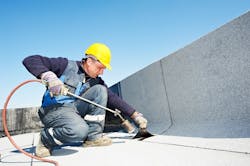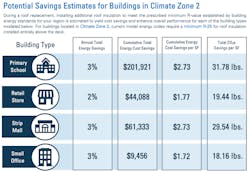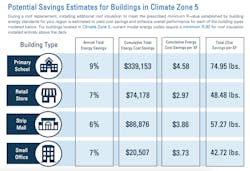How to Save Money with Code-Compliant Roof Replacements
Building owners often brace for sticker shock when faced with the prospect of a roof replacement. They know the reasons why it is important to replace a roof at the end of its service life—before deterioration of the roof leads to water infiltration or structural damage that will make the project bigger and more costly.
What they may not realize is that using the innovative roofing materials available today may enable them to offset initial costs of the project with long-term energy savings while also improving building comfort and reducing the building’s carbon footprint.
Countless non-residential buildings across North America are topped with low-slope roofs that are nearing the end of their useful service lives and are severely under-insulated compared to today’s modern energy code standards. Since the roof is typically a building’s largest thermal envelope surface, these buildings feature hundreds of millions of square feet of roofing area that is continuously allowing heat gain into conditioned spaces in warm weather and heat loss in the winter. This heat transfer leads to significantly higher energy costs that are compounded when fuel prices soar.
[Related: The Facilities Manager’s Guide to Insulation]
Many current building codes require upgrading roofing insulation levels to current standards whenever a roof is replaced or altered. Some owners may balk at the added cost of these energy upgrades on an already capital-intensive project. A recent study conducted by ICF International, a global technology services and consulting firm, should ease these concerns—it delineates how upgrading to energy code-compliant roof systems substantially reduces whole-building energy use, leading to decreased energy costs and carbon emissions that pay for themselves many times over during their expected service lives.
ICF draws the following general conclusions about roof replacements from the study:
- Even when subjected to higher incremental installation costs and discount rates, roof replacements are life-cycle economical under various conditions.
- Through a significant reduction in natural gas fossil fuel use and overall improvement in energy efficiency roof replacements support the transition to building electrification.
- By offering a cost-effective tool to help building owners reduce energy use and lower their carbon footprint, roof replacements support building performance standards and carbon emissions reduction goals.
This study, commissioned by the Polyisocyanurate Insulation Manufacturers Association (PIMA), quantifies the energy and carbon emissions savings from code-compliant roof replacements on common building prototypes established by the U.S. Department of Energy in reference cities representing ASHRAE Climate Zones 2-6 for the U.S. and Canada. Climate zones are critical indicators to guide the proper roof insulation selection for any building, it is critical to consider the climate zone for its location.
Below are a few sample findings from the study, grouped by example city. Findings from the entire report can be found here.
Tampa, Florida (Climate Zone 2)
Cities located in ASHRAE Climate Zone 2 are characterized as hot climates, which is defined as an area that has temperatures that exceed 67 degrees F. for a minimum of 3,000 hours during the warmest six months of the year, and/or exceed 73 degrees F. for a minimum of 1,500 hours during the warmest six months of the year.
In warm climate zones where building energy expenditure is often dominated by cooling processes, an inefficient thermal building envelope can waste electricity and generate unnecessarily high utility bills. Installing an energy code-compliant roof replacement in Climate Zone 2 (R-25 for insulation entirely above the roof deck) is estimated to generate whole-building energy savings of 2-3% annually depending on the building type.
This translates into cumulative energy cost savings per square foot of $1.72 to $2.73 and carbon equivalent emissions reductions per square foot of approximately 18 to 32 pounds.
[Related: Why This Multifamily Building Pursued Passive House Certification]
Chicago, Illinois (Climate Zone 5)
Cities located in ASHRAE Climate Zone 5 are characterized as cold climates, which is defined as an area with between 5,400 and 9,000 heating degree days on a 65 degrees F. basis.
In cold climate zones where building energy expenditure is often dominated by heating processes, an inefficient thermal building envelope can waste gas and electricity, generating unnecessarily high utility bills. Installing an energy code-compliant roof replacement in Climate Zone 5 (R-30 for insulation entirely above the roof deck) is estimated to generate whole-building energy savings of 6-9% annually depending on the building type.
This translates into cumulative energy cost savings per square foot of $2.97 to $4.58 and carbon equivalent emissions reductions per square foot of approximately 43 to 75 pounds.
Rochester, Minnesota (Climate Zone 6)
Cities located in ASHRAE Climate Zone 6 are characterized as cold climates, which is defined as an area with between 5,400 and 9,000 heating degree days on a 65 degrees F. basis.
In cold climate zones where building energy expenditure is often dominated by heating processes, an inefficient thermal building envelope not only wastes energy and money, it can lead to increased occupant discomfort generated by air movement (i.e. air leaks) through the building’s exterior.
Installing an energy code-compliant roof replacement in Climate Zone 6 (R-30 for insulation entirely above the roof deck) is estimated to generate whole-building energy savings of 6-11% annually depending on the building type. This translates into energy cost savings per square foot of $3.34 to $5.88 and carbon equivalent emissions reductions per square foot of approximately 43 to 103 pounds.
Read the full report of the study and download Climate Zone-specific fact sheets.
About the Author:
Justin Koscher is the president of the Polyisocyanurate Insulation Manufacturers Association (PIMA).
Read next: New Building in Spokane to Become Largest Net Zero Energy and Carbon Building in North America
About the Author

Contributed Author
BUILDINGS partners with industry experts to bring you contributed content covering the hot topics for building owners and facility professionals.






